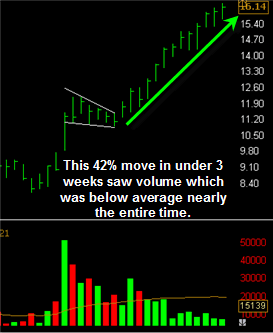 Author Archive for Jeff White
Author Archive for Jeff White
Jeff White is the founder of www.TheStockBandit.com, a nightly newsletter for active traders. He has been trading his own account for over a decade and currently trades full time in Texas.
Taking Risks
August 26, 2009 at 1:10 pm
It’s a known fact that in the market, you get paid to take risks. We all know that, right?
But are you getting the proper rewards for those risks? Are you taking the most appropriate kinds of risks? And perhaps most importantly, do you recognize the extent of the damage which can be done when you take on risks which are larger than you can handle?
I’m in the midst of re-reading a great book on risk right now (I’ll put up a post before too long about it, because it’s something you should read), and it’s got my wheels turning. I’m reconsidering exactly what is risk, how much I should be taking, and why I need to embrace it.
Before sharing too much about the book, let me share with you a couple things which are on my mind right now, and I’ll lay out the rest in a later post once I’ve finished the read.
Defined Risks are the Best Kind
Option traders often refer to their ‘max risk’ on a given trade, because on some strategies they are able to truly limit their downside risk to a set amount. If they’re long premium, the most they can lose is 100%, for example.
But an equities trader like me needs to think in terms of a different kind of risk factor. Yes, I could buy 1,000 shares of XYZ at $20 per share, and my max risk (in terms of capital outlay) would be $20,000. But that’s not realistic risk, because it’s so incredibly unlikely that stock is headed to $0 – especially over the course of a few days when I’d expect to be in the trade.
Instead, it’s important when trading stocks to think in terms of max $ risk if the trade fails (not if the underlying company fails). I touched on this concept of dollar risk per trade earlier this month, but let’s look a little closer at it. If I know my entry and I can designate a stop loss on the trade, then barring any drastic circumstances I’ll be able to exit at or very near that stop should an adverse move occur. That’s the risk I want to be familiar with. The kind of risk that says “if this trade doesn’t work out, what do I stand to lose?”
That’s very different from simply looking at every trade from a capital outlay perspective. It’s a major shift for some of you to start thinking this way, but it can also make a major impact on your trading to implement it.
Know Your Exit
Making what could turn out to be a difficult decision before getting in the heat of the moment can be the most important part of your trading plan. It’s one thing to hunt for entry after entry, locating breakout levels and spots where trend lines could get broken, but it’s an entirely different thing to know where you’ll look to exit that same trade, whether it moves in your favor or not.
I’ve said before that a good trade is usually a planned trade, and that definitely involves knowing your exit from the outset of the play. So before you place that order to enter your next trade, decide on where you’ll get out of it. Set a bracket order or jot it down, or at least verbalize it somehow! That’s still better than thinking you’ll get around to it later. Don’t procrastinate – decide on an exit.
Have a Goal
There is no reward without risk, and there should be no risk without reward. Knowing this, there’s absolutely no reason why each trade shouldn’t have some favorable objective associated with it, so set a goal for each trade. A realistic one that could quite feasibly be reached during the course of the trade.
Perhaps you’ll set a hard target and book profits once that level is reached regardless of how strong the momentum seems at the time. Or perhaps you’ll plan to book partial profits at intervals along the way.
At the very least, having some idea of a level where your stock could move to is still going to help you formulate a game plan, even if you don’t choose to leave a resting order in that zone to book profits.
If you know your stop and you have some kind of upside expectation, then you’ll have a far better grasp of just what your risk is on a given trade and whether or not it should be taken.
Thanks for stopping by and I’ll see you here soon with more. Until then…
Trade Like a Bandit!
Jeff White
Hard Stops vs. Mental Stops
August 20, 2009 at 10:15 am
When I’m swing trading, I prefer to place stop and target orders via bracket orders. That means I’ve got pending orders which will cancel out the other side based upon what gets executed first. I’ve got a hard stop in place just in case of an adverse move in price, and I’ve got a limit order in case of a favorable move.
This set-it-and-forget-it style of trading works well for me on the multi-day timeframe. First, I don’t need to watch every tick. I can trust that my orders are doing the job for me, because generally those stop and target levels are several percentage points away. Second, it helps to keep me from micro-managing trades. I don’t get so consumed with the intraday chart that I abort my original game plan. That’s good.
But when it comes to intraday plays, or day trades, I often times will take a slightly different approach by using a mental stop. There are a few reasons for this:
1. I’m watching the price action closely and developing a feel for the move that’s taking place. I will know the area where I’ll plan to exit the trade before getting in, but in the first few minutes I may not have a specific, hard number that I’m ready to commit to. That’s simply part of tape reading on a trade that may only last minutes.
2. Because I’m watching the price action, by default I’m at the PC. That means I’m able to blow out of the trade instantly when I realize the time has come that I’d rather have the cash than the shares.
3. Since my intraday timeframe is about minutes or hours, it’s often a bit tougher to continually place and cancel orders for the same trade as it progresses. Ideally, the stock is moving in the intended direction and I’m eyeballing areas on the chart where I’ll need to book some gains or begin to lighten up (or even exit entirely). Those levels change continually based upon the momentum of the stock, so I often times defer to sort of a “mental trailing stop” whenever that’s the case.
4. Fortunately, I’ve never struggled with blowing stops, so I can trust myself to bail on a trade when it’s time to. And again, I know going into the trade the general area where I’ll get out, so even if that’s crossed right away then my decision is made. My struggle generally lies with staying with big winners and allowing them to become huge winners, but that’s a topic for another discussion.
Which One is Right For You?
The answer to this depends on your personal style, and some real honesty is required on your part with this one. But it is rather simple.
If your tendency is to blow mental stops, then set hard stops in your trading platform and leave them alone. End of discussion. It’s for your own good.
If you prefer mental stops, insert support or resistance levels on your chart (literally draw them) so that you’ll at all times have a visual representation of where your trade stands and if the time to bail out is approaching. I often set red support levels and green resistance levels as sell and buy markers for trades. Whatever you do, be consistent and don’t hesitate to kick that trade out the door when it stops behaving.
Bottom line: if you know deep down inside that you lack the discipline to cut a losing trade when the time comes, put a hard stop in place. And if your problem is simply staying in a winning trade when you know you should, consider scaling out on the way up.
Thanks for stopping by and I’ll see you here soon with more. Until then…
Trade Like a Bandit!
Jeff White
Are you following me on Twitter yet?
Peace of Mind With Bracket Orders
August 12, 2009 at 9:54 am
Trading is stressful enough on it’s own, and all of us can at times have outside distractions which pull our attention away from the trading screens. Whether it’s a work project, a trip to the doctor, travel plans or tax season, there can be a constant flow of interruptions to your trading.
Some of them can mean actual losses while others mean missed opportunity, but the bottom line is that that’s life and we have to find ways to get around them if we want to push ahead with our trading.
Enter the Bracket Order
I’ve been using these with thinkorswim for some time now, and I’ve really been pleased. Their platform has a ton of features for options traders, but they didn’t neglect those of us who trade stocks.
I particularly like the bracket order capabilities, and I use the ‘1st Triggers OCO’ all the time in my swing trading. It’s nice to be able to set up a trade when you know your entry, stop and target, and be able to trust that it is being taken care of so that you don’t have to watch it. That allows me to spend my time seeking out new trades rather than managing existing positions.
These conditional orders are pretty amazing, and they’ve gotten sophisticated enough that they can accomplish pretty much whatever you want done at whatever time you want it. What originated as a simple alert has evolved into a multi-faceted tool which many of us will never again trade without.
Traditional order types are available everywhere, and if used properly can sure help you implement your trading plan better than you could without them.
But why ride the bus if you can be chauffeured around in a limo?
Using old-school order types like a stop buy order can certainly help you catch an entry on that trade you’ve been stalking, but won’t you need to protect your capital with a stop loss order rather quickly after your order is filled? What happens when that busy life of yours prevents you from being at the PC when it’s time to put in that safety net? You’re up a creek without a paddle.
If you could structure your entire trade in one order, wouldn’t you do it? If you know the price at which you’ll enter a trade, stop out, and take profits, then let technology help you. I can’t think of an excuse good enough to avoid using these orders, because they truly are the best thing out there.
How it Really Works
I’ve been using this functionality in the form of ThinkOrSwim’s “1st Triggers OCO” orders, so let me explain. The “1st” portion is my entry order, such as ‘buy XYZ @ $25.” The ‘Triggers OCO’ portion means that once I am filled on my XYZ purchase, a One-Cancels-Other order is immediately and automatically placed.
This latter portion is actually a pair of orders which the system will manage for me. If I set a limit sell at a higher price for taking profits, and a stop loss down below as my safety net, then I’ve structured my XYZ trade in such a way that I know my risk and my potential reward. Because I only want to sell my shares once but yet have two sell orders, the system will automatically cancel the remaining order once the first one is filled. So if XYZ climbs to my target and I sell for a gain, my stop loss order is canceled. If on the other hand XYZ were to fall to my stop level before reaching my profit target, the system will execute my stop and cancel my remaining (unfilled) limit order since I no longer own shares to sell. Pretty sweet!
Here’s a video explaining it. Select the HD option and go full-screen for best quality:
Bracket orders are excellent tools which offer the trader a ton of flexibility (there are many more of these advanced order types), but in my opinion the best thing they offer is peace of mind.
There’s just something about knowing that your plans for a trade will be carried out whether you’re at the PC or not. That gives me the freedom to put my trading ideas into motion, knowing full well that I will be able to book profits where I see fit and yet limit my losses in case I am wrong (barring an adverse price gap in the stock of course).
If you’re not using conditional orders in your trading, you should be! They can quickly become a part of your daily routine, giving you the ability to trade to your heart’s content without letting life’s distractions interfere with your plans!
Trade Like a Bandit!
Jeff White
Producer of The Bandit Broadcast
Scale Out of Winning Trades with Partial Exits
August 4, 2009 at 12:55 pm
It’s common among traders to think that you either have to be all-in with a stock or all-out of a stock, but that sure isn’t the case.
Many of us do our buying in one piece, entering a full position at one time as an important level gets crossed. This is my personal preference, as I continually seek out trading opportunities where a ceiling is shattered or a floor implodes, enabling price to make a nice move through it.
And when I am wrong (yes, when, not if ), I’ll exit in one piece. As events occur or conditions emerge to show me that the stock is clearly moving in the opposite direction of what I had expected, I’m going to bail out of the trade and protect capital.
So, I’m getting into trades in one piece, and I’ll stop out of trades in one piece. But rarely will I exit a winning trade in just one piece. Instead, I’ll scale out.
Advantages of Incremental Profit-Taking
Over the years in dealing with traders from literally around the globe, I’ve found that very few of them will get out of favorable trades in pieces. Adopting this method of booking profits can be an excellent way to trade, and particularly in a momentum-based market like the one we currently find ourselves in.
Taking partial profits and peeling off a portion of your position on the way up carries with it several advantages. Let’s look at a few…
1. You can lighten your exposure into favorable moves. As your trade makes its move, it’s a great idea to start reducing your position size. The idea is that as a move progresses, it naturally becomes more difficult to capture similar returns to the initial move. Typically stocks surge early, so this is a way to take advantage of that early momentum.
2. Make room for new opportunities. This isn’t just for those who may be trading with a smaller account and need to raise cash to put toward a new play. In fact, even traders with larger accounts may find it difficult to manage a lot of positions in terms of the attention they can devote to each trade. Catching the move you initially were seeking can remind you that it may be time to shed some shares and seek out another stock to put your money and/or attention into.
3. Let slippage work in your favor. Posting offers on the way up means you’re capturing the bid/ask spread – not paying it. I use market orders for entries and for stopping out, because when I need to be in or out of a trade I don’t want to haggle over a few cents. But when it comes to booking profits, limit orders resting at higher levels mean you’re out there offering out some inventory, letting someone else pay up for it.
4. Satisfy the urge to take cash off the table, yet still stand to gain from a continued move. This is a big confidence booster as well as a way to manage money wisely. Turning some of those paper gains into real profits not only pads your account, but it also reinforces that you’re on the right track. Gaining some momentum in your trading is a great thing, both for your account and for your psyche. And by adjusting the stop for remaining shares, keeping even a portion or a core position allows you to benefit from a major move, should it occur.
Trade Like a Surfer
Just as a surfer catches one wave after another, a good trader maintains the same mentality. Ride the best moves you can find, but don’t be shy about easing out of a trade once you’ve caught a nice move. Paddling back out to locate the next one will require your availability, so when you start smiling about a trade, it’s probably time to start scaling out.
The fear of missing out on a giant run keeps many traders from selling at all, but scaling out carries with it the best of both worlds.
Consider making partial sales in your next winning trade, and see what it does for your bottom line. It just might be the best adjustment you make this year.
Thanks for stopping by and I’ll see you here soon with more. Until then…
Trade Like a Bandit!
Jeff White
Are you following me on Twitter yet?
Momentum Trading – A Different Mindset
August 3, 2009 at 7:17 am
After a lengthy period of indecisive, range-bound price action, we’ve seen the market gather some momentum in recent weeks. The push from the July low was rapid and relentless – clearly a change of character.
The landscape tends to shift like that from time to time. Sometimes key levels serve as steadfast boundaries for price and don’t allow it to gather any steam in either direction. But at other times, we’re in a run-and-gun market where we get trend days after trend days, and follow through is far easier to come by.
Let me be clear though: that doesn’t mean it’s easy.
In fact, the momentum game really requires a different kind of mindset for success. Dare I say, it can be much tougher on the experienced trader.
Let me explain why.
Mindsets of the Amateur and the Adept
First, let’s examine the novice. Generally, their approach can be quite simple…
See green, go long.
See red, sell.
Often times, they may not even consider how much green they’ve just seen – all they know is that there’s strength present, so they buy without concern.
This mentality contributes to the momentum, and when it’s particularly strong, they make money without much stress. Soon they’re saying, “I think I might quit my day job!”
On the other hand is the experienced trader. A guy like me finds it particularly difficult to chase stocks, because in my post-beginner trading phases I’ve bought the top or sold the low. It isn’t fun. Experiences like that can leave you a little gun shy, and it becomes a habit to recognize at which point a play has moved too far for a new entry. Thoughts creep in, such as “Is this market ever gonna rest?”
So, seeing a stock which just ran 5% intraday, for example, leaves me far more likely to respond with an I’ll catch the next move mentality. I know how nice it is to have some inventory to flip out to those late-comers after a big pop, so when moves start getting extended, my preference is to start lightening up instead of adding.
This “I forgot my track shoes today, so I won’t be a chaser” mentality might frequently serve to help me protect capital, but during those times when powerful momentum is present, it can actually cost me opportunities.
Shifting Gears
Knowing this, how bout we take a look at 3 ways to identify and trade momentum. That could help us adjust when the conditions warrant hopping on board the train when it’s already in motion.
1. Recognize a change of character. Paying close attention to the environment you’re trading in will make it more obvious that your approach should change accordingly. Perhaps recent advances have been 3-4%, and suddenly a 6% move arrives and shows no signs of fatigue. That’s a change of character, and it’s a signal to shelve your current strategy for the time being. And if you don’t have another style to turn to, then it’s time to seek out another way to profit.
 2. Watch the volume. Under normal circumstances, even with a trend, we can compare upside volume to downside volume and notice some patterns emerging. For example, an uptrend might see spurts of strength accompanied by higher volume, and periods of rest accompanied by lighter volume. But when real momentum arrives, the volume may not follow that same pattern. Price simply gets on the move and keeps the pedal to the metal, and volume doesn’t have to play a major role. Market participants are simply caught off guard, and there’s a persistent move as they jockey for position. Many times that results in consistent volume levels which don’t surge and contract like they do during a rally-rest-rally type of phase.
2. Watch the volume. Under normal circumstances, even with a trend, we can compare upside volume to downside volume and notice some patterns emerging. For example, an uptrend might see spurts of strength accompanied by higher volume, and periods of rest accompanied by lighter volume. But when real momentum arrives, the volume may not follow that same pattern. Price simply gets on the move and keeps the pedal to the metal, and volume doesn’t have to play a major role. Market participants are simply caught off guard, and there’s a persistent move as they jockey for position. Many times that results in consistent volume levels which don’t surge and contract like they do during a rally-rest-rally type of phase.
3. Notice when a pause is ignored. If you’ve been trading for almost any length of time, you’ll notice times when price starts to get a little stretched and is getting due for a rest. If that rest is not allowed, then momentum is definitely present. Lace up those running shoes, you’re probably gonna need ’em.
Emotion in Motion
One last note on this topic, which is that support and resistance levels are largely ignored when the momentum train is running.
That means if you’re looking for reversals or pauses at ‘logical’ zones, fugettaboutit! Not likely to happen. Momentum arrives when more emotion is present than logic, and emotion stops for no level.
Those typical reversals near key levels we tend to see during quieter times just aren’t going to happen, so go with the flow and don’t fight it until the tape tells you it’s tired.
Thanks for stopping by and I’ll see you here soon with more. Until then…
Trade Like a Bandit!
Jeff White
Are you following me on Twitter yet?
Protect Capital Even in a Bull Market
July 27, 2009 at 8:03 am
 This market sure has been strong – we have yet to see a pullback which has lasted longer than a few minutes!
This market sure has been strong – we have yet to see a pullback which has lasted longer than a few minutes!
Instead, we’ve merely seen brief pauses of sideways price action, which is quite nice…if you’re long.
A powerful market like this does have a downside though, which is fewer quality setups for new long side entries. And shorting? Well, let’s just say some feelings have been hurt for the bears!
We’ve come a long way since the July 8th lows, and right here, it’s very easy to chase stocks if you want to get long. It feels like it almost can’t go down (famous last words), and thus confidence is really high. But that doesn’t make buying here a good decision. In fact, sometimes it’s best to actually let the market come to us after such a move.
Protecting capital is the top priority of all successful traders. Making money is secondary.
Even strong bull markets like what we’re seeing right now require that we protect capital. It’s easy right now to think making money on the long side must be easy when the market rallies almost daily.
But trading out of fear that the market will run off and leave you behind is a recipe for forcing trades, which will usually cost you more money than it’ll make you!
Stay Focused
Our job as traders is to take only the best setups with the highest reward and lowest risk associated with them.
Keep that in mind here, as the market remains quite extended on a short-term basis. Manage your open positions the best way possible, and be willing to patiently let the market come to you. Once it does, then set up new trades.
There will be plenty of good setups in the next few days and weeks, but it isn’t wise to lower your standards and buy stocks that are technically extended just to get long.
A lasting bull move will offer plenty of chances to buy, and that’s best done on pullbacks or after resting phases. If this breakout sticks, we should see many opportunities in the weeks to come.
Thanks for stopping by and I’ll see you here soon with more. Until then…
Trade Like a Bandit!
Jeff White
Are you following me on Twitter yet?
Video Review of the Indexes 7-26-2009
July 26, 2009 at 4:43 pm
Moving out of a multi-month trading range has been a very welcomed sight for many traders in the past week. It has meant an expansion in volatility, greater momentum than we’ve seen in a while, and new recovery highs for the market from the March low.
However, the way in which it has happened obviously caught quite a few people off guard. The emotions have combined for a panic buying atmosphere, ripping bears in the process while sparking fears among bulls with cash that prices may never again retreat.
That’s not a logical view of course, but anytime there’s a big move taking place it’s common to see emotions behind the action.
Nonetheless, the indexes are getting back on the move. And although a rest or pullback from here would be welcomed and healthy, we’re still waiting on it to arrive. While we wait, it’s a great time to examine some important levels for the indexes to keep an eye on in the days ahead.
This clip was also posted over on the Trading Videos site (as always), and perhaps you’ve seen it there – but in case you didn’t, I wanted to put it here on the blog for you.
Let me highly suggest clicking the “HD” on the video player and then going full-screen for best quality.
Thanks for stopping by and I’ll see you here soon with more. Until then…
Trade Like a Bandit!
Thanks for stopping by and I’ll see you here soon with more. Until then…
Trade Like a Bandit!
Jeff White
Are you following me on Twitter yet?





